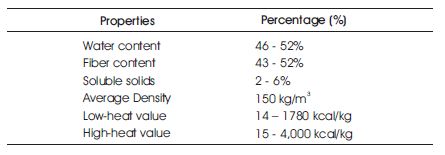
Table 1. Properties of Bagasse.
India has been suffering from an acute shortage of electricity for several decades. The main reason is that there is a large gap between the demand and supply of electricity. Therefore, the government of India has recently promoted cogeneration in the sugar industry. The national power generation potential from bagasse cogeneration, according to the Ministry of New and Renewable Energy (MNRE), a study by the Government of India, is about 3,500 MW, while Maharashtra's potential is 1,250 MW. Indian Sugar Industries has the potential to produce an excess capacity of up to 5,000 MW in all sugar mills. Maharashtra again became India's leading sugar-producing state five years later. It overtook Uttar Pradesh in sugar production. The total sugar production in Maharashtra is 138 thousand metric tonnes for 2021–2022. In India, the sugar industry is the second-largest agro-industry and contributes significantly to the socioeconomic development of the country. Sugarcane is the main raw material for sugar production in India. Sugar cogeneration is the concept of producing two types of energy from one fuel. One form of energy must always be heated, and the other may be electricity or mechanical energy. In the cogeneration industry, very high-efficiency levels in the range of 75% to 90% can be achieved.
The sugar industry has traditionally practiced cogeneration, using bagasse as fuel. With the development of technologies for the production and use of steam at high temperatures and pressures, the sugar industry can produce electricity and steam for its own needs. Using the same amount of bagasse, it can also generate significant surplus electricity to sell to the grid. For example, if the steam temperature and pressure are raised from 530°C and 109 kg/cm2, more than 0.45 MWh of additional electricity can be generated per tonne of bagasse (Bhutto et al., 2011). Selling surplus electricity generated through optimal cogeneration will help the sugar mill improve its viability, in addition to increasing the country's generating capacity. The Indian sugar industry has the potential to generate up to 5,000 MW of surplus electricity from all sugar mills in India. Maharashtra again became India's leading sugar-producing state five years later. It overtook Uttar Pradesh in sugar production. The total sugar production in Maharashtra is expected to reach 138 lakh tonnes in 2021–2022 (Global Climate Change - Vital Signs of the Planet, n.d.).
When sugar cane is processed industrially, a by-product known as bagasse is formed along with refined sugar. The word is derived from the French word for "baggage" and also from the Spanish word "bagazo," which means rubbish (Mirza et al., 2008). After some modifications, the material is proved to be a good biofuel, i.e., for heat generation as well as the subsequent generation of electricity in the sugar industry. This process is often called cogeneration (Hakeem et al., 2014). It was observed that a tonne of sugarcane yields about 300 kg of bagasse, i.e., about 30% (Bhattacharyya & Thang, 2004; Hofsetz & Silva, 2012; Paturau, n.d.). Thus, for a continuous supply of bagasse, the sugar refinery simply needs to continue the refining process, thereby producing a renewable resource needed to meet almost all energy needs as well as excess electricity. According to the analysis, approximately 3 kg to 7 kg of pulp is required to generate 1 kWh of electricity (Hofsetz & Silva, 2012). The bagasse tariff is frequently compared to the cost of conventional fuels.
In the last decade, the world has witnessed the possibility of using bagasse as a biofuel. Many countries have adopted the method of cogeneration in sugar mills to meet heating needs as well as to produce a significant amount of electricity, including Brazil, Pakistan, Turkey, Zimbabwe, India, and Australia (Mishra et al., 2014), etc. Being the largest producer of sugar in the world, Brazil has made the use of bagasse as a biofuel a reality (Paturau, n.d.). Along with the production of ethanol from sugar, bagasse is also produced to meet heating and power generation needs. In India, the beet pulp-based sugar industry has the potential to generate up to 5,000 MW of surplus capacity in all sugar mills.
Bagasse is a naturally fibrous fuel that contains a non-fibrous material inside, called the core, with a moisture content of about 50%. Its calorific value is 2300 kcal/kg. About 2.5 million tons of sugar cane are needed to produce 0.21 million tons of cane sugar. Bagasse makes up 30% to 35% of crushed sugar cane. The composition of the beet pulp varies depending on the variety and maturity of the sugar cane, as well as the harvesting methods used and the efficiency of the sugar mill in processing the sugar cane. Bagasse properties are shown in Table 1.

Table 1. Properties of Bagasse.
In the sugar industry, bagasse is commonly burned in steam ovens to generate electricity. It is also used as a raw material for paper production and as cattle feed.
India is the second-highest producer of sugarcane in the world after Brazil. The largest producer of sugarcane in India is Uttar Pradesh, which produced over 177 million metric tones of sugarcane in 2021. Sugarcane is a multipurpose crop, used in making sugar, jaggery, Khansari, molasses, and even paper. In India, approximately 60% of the population is involved in agriculture, and among the many crops cultivated in the nation, sugarcane is one of the most important Kharif crops. The climate of the country supports the plantation of sugarcane throughout the year. Figure 1 and Table 2 show the total installed capacity as of 31.08.2022.Figure 2 shows the percentage of each power sector.

Figure 1. Total Generation Capacity.

Table 2. Installed Generation Capacity- Sector Wise.
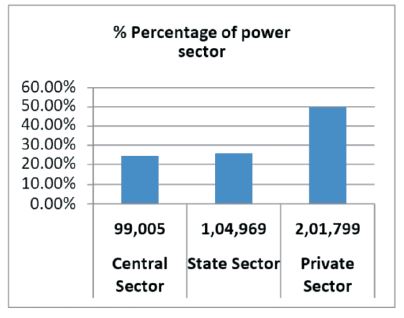
Figure 2. Percentage of Power Sector.
Table 3 shows the total generation and growth over the previous year in the country from 2009-2010 to 2022-2023.
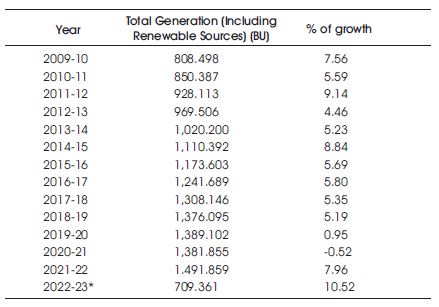
Table 3. Total Generation and Growth.
Figure 3 shows the total generation including renewable energy sources from 2009 to 2022. Figure 4 shows the year wise growth percentage and Table 4 shows the list of the largest sugarcane-producing states in India in 2021.

Figure 3. Total Generation Renewable Energy Sources (RES).
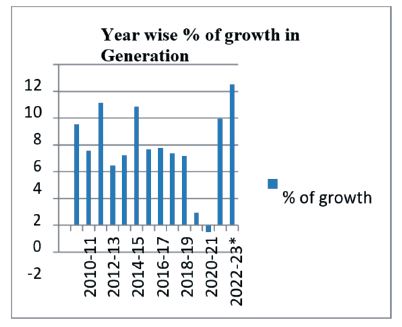
Figure 4. Year Wise Percentage Growth
Figure 5 shows the state wise production from 2015-2016 to 2019-2020 of various states such as Uttar Pradesh, Maharashtra, Karnataka, Tamil Nadu, and Bihar. Figure 6 shows the total percentage of production over each state.
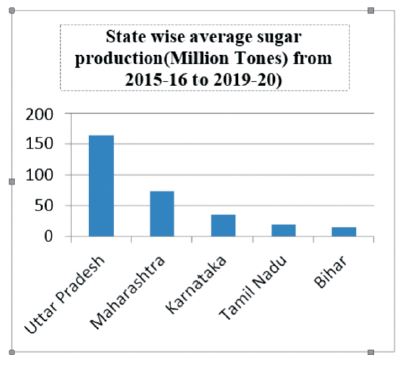
Figure 5. State Wise Production
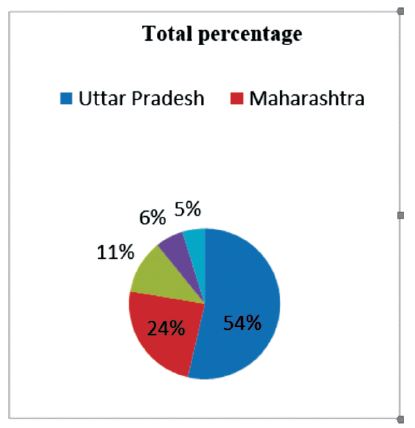
Figure 6. Total Percentage
Modern power plants use higher pressures, up to 87 bars or more. Higher pressure generally produces more power for the same amount of bagasse or biomass fuel. Thus, a higher pressure and temperature configuration is the key to increasing the surplus electricity exported. In general, the 67-bar, 495°C configurations of sugar refinery Combined Heat and Power (CHP) units have performed well in many sugar mills in India. Extra -high pressure of 87 bars and 510 °C, a configuration comparable to Mauritius, is the current trend, and several projects have been commissioned and are operating in India and Brazil. The average increase in power output from 40 bars to 60 bars and up to 80 bars is usually in the range of 7–10%. A promising alternative to steam turbines is gas turbines operating on gas obtained from the thermochemical conversion of biomass (Parikka, 2004). The exhaust is used to lift steam in heat recovery systems used in any one of the following ways, to meet heating process requirements in a cogeneration system; for back injection into a gas turbine to increase power output and efficiency in a steam injected gas turbine (STIG) cycle; or expansion with a steam turbine to improve power output and efficiency in a Gas Turbine/Steam Turbine Combined Cycle (GTCC).
Gas turbines, unlike steam turbines, have lower unit capital costs on a small scale, and the most efficient cycles are significantly more efficient than steam turbines of comparable sizes. Figure 7(a) shows the back pressure turbine.
The efficiency of cogeneration plants in the sugar industry is very high, ranging from 75% to 90%, since the low pressure steam leaving the turbine is not condensed but is used to heat and boil juices for processing and concentration. Even if it did not produce that much steam to produce additional energy for use elsewhere with the same amount of steam that the process requires, cogeneration technology offers options in the sugar industry. Cogeneration technologies that are widely used in the sugar industry include two types of steam turbines, such as back pressure steam turbines and extraction/ condensation turbines as shown in Figure 7(b). The choice between a back pressure turbine and an extraction and condensing turbine depends mainly on the amount of electricity and heat, heat quality and economic factors.
When electricity prices are high or are expected to remain high, cogeneration plants can provide significant cost savings. The key to estimating the potential savings from cogeneration is an accurate projection of electricity prices over the next few years. Fossil fuel prices are on the rise as an important component of cogeneration electricity. The sugar industry is one of the most visible and profitable renewable sources, which is the basis of the country's economic development. In terms of using biomass as fuel, cheaper electricity can be produced and greenhouse gas emissions can be minimized. Thus, bagasse could play an important role in replacing fossil fuels for electricity generation in the future.